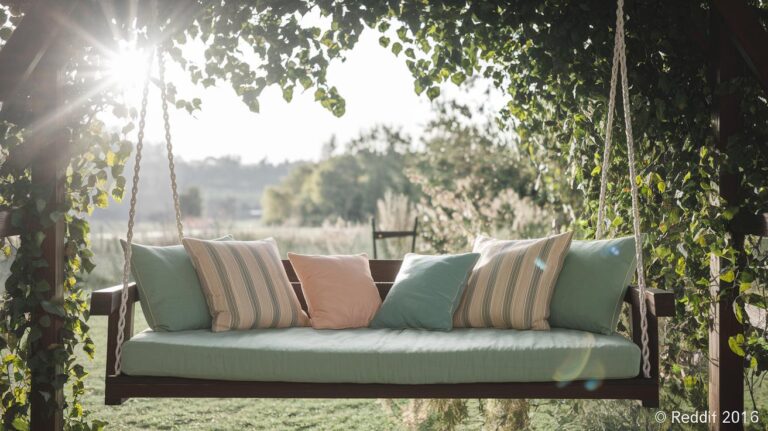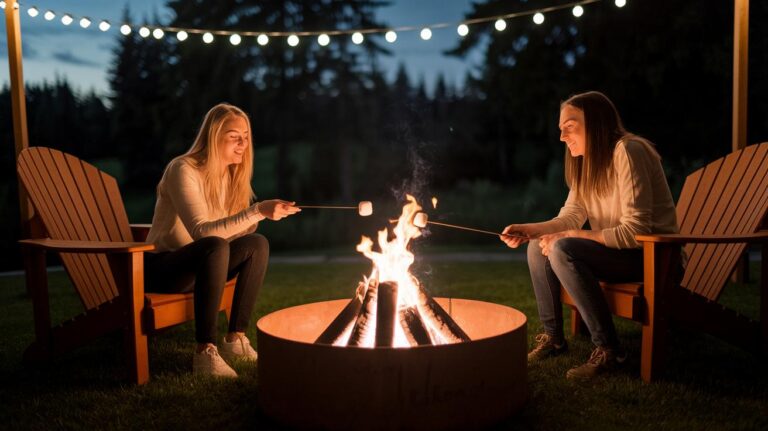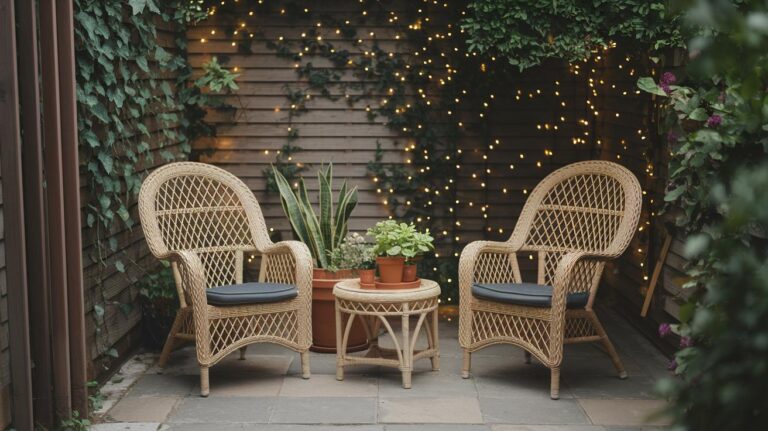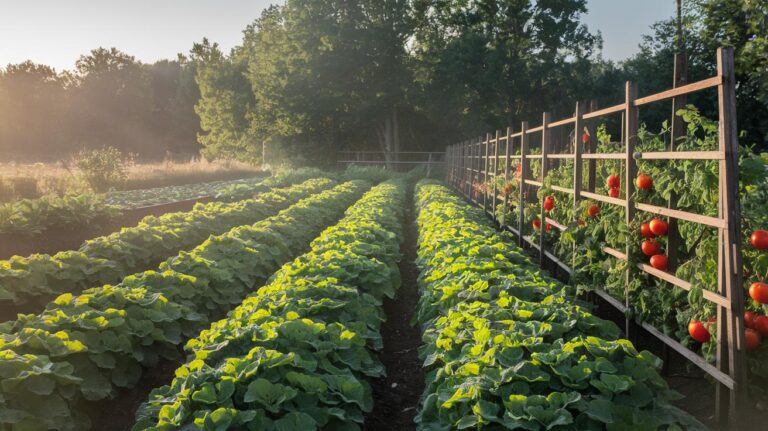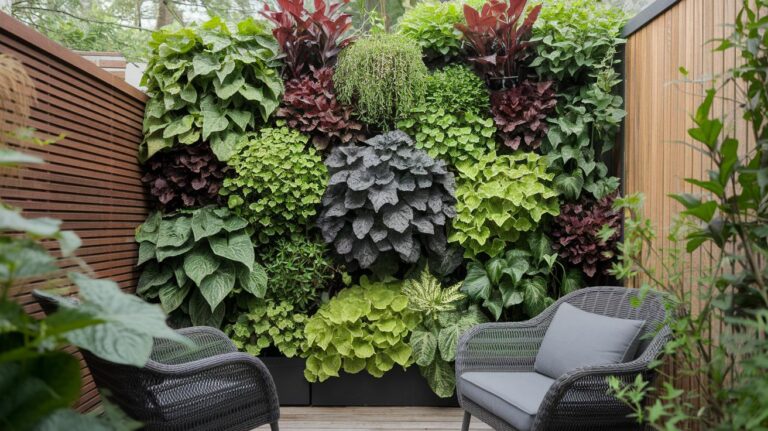Backyard Paradise With Drought Tolerant Plants
Did you know your green lawn can gulp up more than 10,000 gallons of water each year? That’s like filling a small pool. Wow.
Imagine trading that thirsty grass for beautiful, smooth, small stones and sun-loving succulents. You’ll only need to water these drought tolerant plants once in a blue moon. And you’ll never hear a mower again.
I tried it last summer with heat-tolerant blooms and succulents, and I haven’t looked back. Oops, I dropped a succulent leaf while planting. Friendly birds and butterflies swoop in like ticketed guests at a summer show. By the way, my cat loves to snooze on the rocks.
In this post, you’ll learn simple steps to replace turf with colorful, drought-tolerant plants. You’ll end up with a backyard that stays lovely without endless watering or mowing.
No Grass Backyard Benefits and Overview
So, what is a no grass backyard? Picture stepping onto soft gravel that crunches under your toes. This make-over helps you save water and cuts down on yard chores. You’ll watch the water bill drop and ditch the weekly mow (and that sore back).
By swapping lawn for stone, patio pavers, and easy-care plants, you get a fresh, relaxed vibe. Birds will swoop in. Butterflies too. And you’ll finally have time for porch chats or a backyard book break.
- Water savings
- Less upkeep
- A welcome home for wildlife
- Fun all year long
- Lower bills
Here’s how to build your grass-free retreat:
- Hardscaping with patios, pavers, and edging
- Drought-tolerant plants (they need little water) and native plantings (local favorites)
- Groundcovers like gravel, mulch, and decorative stone
- Simple DIY steps for a grass-free layout
- Budget planning and easy maintenance tips
We’ll walk you through all the pieces, plant choices, materials, and cost plans. Then you’ll see how easy it is to create a backyard that feels alive, not lawny. Ready to get started?
Hardscape & Groundcover Materials
| Material | Durability | Cost | Maintenance |
|---|---|---|---|
| Patio pavers (concrete, brick, natural stone) | High | $15–$25 per sq ft | Just sweep or wipe |
| Edging (steel, stone, recycled plastic) | Medium | $2–$5 per linear ft | Check alignment yearly |
| Pea gravel and decomposed granite (broken-down rock) | Medium | $1–$3 per sq ft | Add more each year |
| Decorative stone and mulch (wood chips or bark) | Low to Medium | $0.50–$2 per sq ft | Refresh each season |
Structural Hardscapes
Picking the right hardscape makes your backyard feel polished and welcoming. Patio pavers, flat stones in concrete, brick, or natural rock, give you a sturdy spot for morning coffee or a weekend barbecue. They stand up to sun and rain, and a quick sweep clears off fallen leaves. Have you ever clicked pavers into place like puzzle pieces? Keeping those joints tight makes everything look sharp.
Edging stops gravel from spilling into beds and keeps grass from creeping back. You can pop in steel, stone, or recycled plastic strips for neat lines around your plants. For more on edges that don’t budge, see garden edging. Edging costs less than pavers but still holds its shape season after season.
Mix shapes, colors, and patterns so your hardscape feels lively, not flat. A herringbone brick pattern brings old-world charm. Simple square concrete pavers add a modern touch. By blending these pieces, you’ll give your backyard a bit of your own style.
Surface Groundcovers
Gravel paths made from pea gravel or decomposed granite (broken-down rock) feel nice underfoot and drain well after rain. They pack down firm but still let water soak into the soil. Use them for winding walkways or filling gaps between stepping stones. And when you sweep, most of it stays right where you want it.
Decorative stones, river rocks or smooth pebbles, add texture around plants or a fire pit. Scatter a handful in joints or sprinkle them on top of soil to catch dappled sunlight. Mixing pebbles with mulch gives you a lively look when leaves flutter down. By the way, my cat loves batting loose stones, I guess they’re her version of garden toys.
Mulch, whether it’s wood chips or bark, holds in moisture and keeps weeds at bay. Wood mulch warms beds in cool months, while rock mulch won’t wash away in heavy rain or wind. You’ll top it up each season, but it’s such an easy swap that yard work never feels like a chore.
Xeriscape and Drought-Tolerant Plants for a No Grass Backyard

Have you ever gazed at your lawn and wished for something different? That’s the beauty of xeriscape (water-smart landscaping) for a no-grass yard.
Instead of grass, you’ll plant succulents (water-storing plants), cacti (spiky moisture-holders), and ornamental grasses (decorative grass varieties). Then you layer on mulch (a cover of bark chips or leaves) or gravel (small stones) to keep soil damp and cool. These xeriscape landscaping techniques help you save water and cut chores. Check out more ideas at xeriscape landscaping
On a sunny slope, pick drought-tolerant plants like agave, yucca, or prickly pear cactus. Group together plants with similar needs so watering and weeding stay simple.
Adding native shrubs, perennials (plants that return each year), and trees brings vibrant color without extra watering. Choosing plants that belong here honors local wildlife. Mix butterfly weed (flowers that attract monarchs) with goldenrod’s golden blooms and blue indigo petals. Bees, butterflies, and birds will thank you.
By the way, living ground cover plants, such as Asian star jasmine or no-mow dwarf mondo grass, fill bare spots so you won’t miss mowing a lawn. They creep along the soil and keep weeds down.
Soil prep is easy. Loosen the top few inches of earth and stir in compost (decayed organic matter that enriches soil). Then tuck in your drought-tolerant favorites. Cover everything with 2 inches of mulch or gravel. You’ll love the warm earth crumbling between your fingers and the soft hum of a healthy bed.
Space plants so air moves around each leaf. Water new plants deeply once a week, let the water soak in until the soil feels cool 6 inches down. After about a month, you’ll only need to water during long dry spells.
Other ground covers like creeping sedum or lamb’s ear look lovely between rocks and soften hard edges. Once established, most drought-tolerant plants rarely need fertilizer, though a light top-dressing of compost can boost blooms.
Enjoy a backyard that skips the lawn mower and dances in the sun, all with less work and more life!
DIY Steps to Install a No Grass Backyard Landscape
Grab a pencil and make a simple map of your yard. You can also fire up free drawing software if you want. Sketch where you’ll put walkways, benches, and plant beds. Seeing it all laid out helps you guess how much material to buy and finds tight spots before you dig.
Planning and Layout
First pick your seating spots. Think about where you’d love to sit and chat or sip iced tea. Good bench placement can make even a small area feel roomier. Have you ever wished for a path wide enough for two people to stroll side by side? Aim for at least 4 feet of width so you and a friend can walk together.
Next mark your beds and hard edges. Tie string or snap a chalk line right on the ground to trace curves. Or stick flags in the soil to show where you want a gentle bend in the path. And if you’re reusing old bricks or wood pallets mark those spots now so you can grab them later.
Site Preparation and Drainage
Time to clear out grass and weeds. Use a shovel or rent a sod cutter to strip away the green layer. Pile it to one side for compost (decayed organic matter that enriches soil) or haul it off. Rake the soil smooth so rain does not collect in puddles.
Heavy clay soil can feel like thick pudding. Mix in some grit or pea gravel (small rounded stones) to help water seep down. Then lay a 2 to 3 inch layer of crushed rock or coarse sand. Stamp it down with a hand tamper until it feels as firm as a dance floor.
Hardscape Installation
Ready for pavers? It can be fun. Feel the gravel crunch under your boots.
Start by placing your first stone at a corner. Work outward in neat rows. Leave small gaps and fill them with pea gravel so rain drains right through.
Need a curve? Cut stones with a mason’s saw. Then edge the bed with metal plastic or extra stones to keep rows tidy.
Planting and Finishing Touches
Drop a thin layer of topsoil into planting holes before you tuck in each shrub or drought-tolerant plant (plants that need very little water). Press soil around the roots then give each one a deep drink so roots settle in cool, damp earth.
Sweep away stray gravel and dust off the pavers. Spread a ring of mulch (decayed organic matter that enriches soil) around your plants. Take a slow stroll through your new yard. Shift any wobbly stones and fluff up the mulch.
Sit on your bench and soak in your grass-free getaway.
Outdoor Living Features in a No Grass Backyard Space
I like starting with a fire pit set on pea gravel (those little round stones) or paver pads. When the evening air turns crisp, you’ll be roasting marshmallows in no time. Surround the pit with a ring of natural slate for a touch of charm. Then pull chairs in close so everyone can share stories and stay toasty by the glow.
Have you ever heard water trickle and felt it make a small space seem grand? Tuck a fountain into a shady corner and perch a birdbath on top so songbirds can join the show. Sunlight dances on each gentle tier as water spills down. Try easy-care options like a copper bowl or a stack of ceramic tiers, no complicated plumbing needed. The soft hum drowns out street noise, and you’ll find yourself sighing with relief.
Cooking outdoors can feel like pure magic every time you fire up the grill. Build a stone counter with a built-in grill, a prep area, and hidden storage racks for tools and trays. String lights or lanterns above the counter so the fun goes on after dusk. Place bar stools nearby so friends can swap stories and sneak tastes as you cook.
Wide garden paths make wandering around feel like a mini adventure. Line them with pavers or gravel so feet stay clean and each turn feels inviting. Carve out cozy spots, a swing in one nook, a bench under a pergola in another. Back to prepping your space: these little lounge zones give guests spots to settle in and soak up your backyard’s best views.
Cost Planning and Maintenance for a No Grass Backyard

Let’s talk about dollars. A no-grass backyard can be surprisingly wallet-friendly if you get real with your budget. Paver patios feel sturdy under your feet and cost around $15 to $25 per square foot. Xeriscapes (landscapes that use very little water) run about $10 to $20 per square foot.
If you’re hiring someone, tack on about 10 to 20 percent extra for installation and design fees. But cheap doesn’t mean you have to skimp. Mix a few fancy pavers with plain gravel to stretch every dollar. You still get that wow factor.
Your water bill might be the biggest surprise. Installing drip irrigation tubes (thin lines that deliver water straight to the roots) cuts waste by letting moisture seep right where plants need it. I use a rain barrel to catch every drop that falls off my roof. And you can even hide an underground cistern (buried tank for storing water) to double your savings.
These systems work like a team. Rain fills your barrels, and then the drip lines feed flower beds and tough shrubs. You could also try soaker hoses or micro-sprinklers for spot watering, no high utility rates here. Think of your setup like a water-saving squad.
Weeds are the worst party crashers. A layer of weed-barrier fabric (breathable cloth that blocks sprouts) under gravel stops dandelions before they start. Lay the fabric down first, then put your stones on top. Weed pulling becomes nearly a thing of the past.
Add a thin mulch (decayed wood chips that lock in moisture) edge along your plants so stray seeds don’t get any light. By the way, my cat loves sunning on my gravel, it’s a bonus. Back to business, little steps like this keep your yard looking fresh.
Here’s a quick care list to keep it all humming along:
- Check for puddles and clear drains every three months.
- Top up gravel or stone once a year to keep coverage even.
- Prune shrubs and succulents each season to shape them.
- Clean fountains or bird baths once a month.
- Inspect drip lines and rain barrels twice a year.
With just a few simple checks, your backyard stays low-effort and lush all year. Enjoy every moment without sweating the small stuff.
Final Words
We explored why a no grass backyard can mean fewer chores, lower bills, and a lush, unique space.
Next, we compared hardscape options and groundcovers, then picked drought-tolerant plants for easy care.
You got step-by-step DIY tips for laying pavers, edging beds, and planting.
We even dreamed up outdoor patios, fire pits, and cozy seating, plus a budget plan and upkeep checklist.
Ready to roll up your sleeves? Your no grass backyard awaits, brimming with life and joy.
FAQ
What are some budget-friendly, modern, and low-maintenance ideas for a no-grass backyard, including pet-friendly options?
Budget-friendly, modern no-grass yards use pea gravel or decomposed granite paths, concrete or brick paver patios, low-water native plant beds, bark mulch, and dog-safe rubber mulch or artificial turf.
Does a backyard need grass?
A backyard doesn’t need grass; hardscapes and groundcovers save water and mowing time while letting you design a unique, low-maintenance outdoor space.
What can I use instead of grass in my backyard?
You can replace grass with hardscapes like patios and pavers, gravel or decorative stone, mulch, or living groundcovers such as no-mow mondo grass or Asian star jasmine.
What happens if there is no grass?
Removing grass cuts water use and mowing time, lowers bills, and attracts wildlife, though you’ll need stable groundcovers or hardscapes to prevent erosion.
What can I do with a backyard that has no grass?
Turn a grass-free yard into a living space by installing paver patios or gravel walkways, adding seating nooks, planting drought-tolerant shrubs, and mulching decorative beds.


